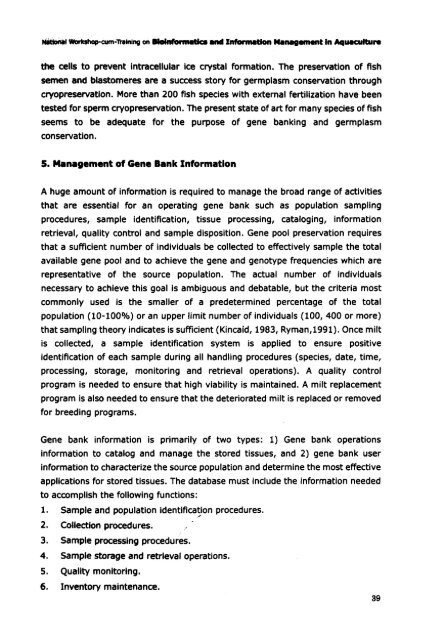4 - Central Institute of Brackishwater Aquaculture
4 - Central Institute of Brackishwater Aquaculture
4 - Central Institute of Brackishwater Aquaculture
You also want an ePaper? Increase the reach of your titles
YUMPU automatically turns print PDFs into web optimized ePapers that Google loves.
the cells to prevent intraceilular ice crystal formation. The preservation <strong>of</strong> flsh<br />
semen and blastomeres are a success story for germplasm conservation through<br />
cryopreservation. More than 200 fish species with external fertilization have been<br />
tested for sperm cryopreservation. The present state <strong>of</strong> art for many species <strong>of</strong> fish<br />
seems to be adequate for the purpose <strong>of</strong> gene banking and germplasm<br />
conservation.<br />
5. Management <strong>of</strong> Gene Bank Information<br />
A huge amount <strong>of</strong> information is required to manage the broad range <strong>of</strong> activities<br />
that are essential for an operating gene bank such as population sampling<br />
procedures, sample identification, tissue processing, cataloging, information<br />
retrieval, quality control and sample disposition. Gene pool preservation requires<br />
that a sufficient number <strong>of</strong> individuals be collected to effectively sample the total<br />
available gene pool and to achieve the gene and genotype frequencies which are<br />
representative <strong>of</strong> the source population. The actual number <strong>of</strong> individuals<br />
necessary to achieve this goal is ambiguous and debatable, but the criteria most<br />
commonly used is the smaller <strong>of</strong> a predetermined percentage <strong>of</strong> the total<br />
population (10-100%) or an upper limit number <strong>of</strong> individuals (100, 400 or more)<br />
that sampling theory indicates is sufficient (Kincaid, 1983, Ryman,l991). Once milt<br />
is collected, a sample identification system is applied to ensure positive<br />
identification <strong>of</strong> each sample during all handling procedures (species, date, time,<br />
processing, storage, monitoring and retrieval operations). A quality control<br />
program is needed to ensure that high viability is maintained. A milt replacement<br />
program is also needed to ensure that the deteriorated milt is replaced or removed<br />
for breeding programs.<br />
Gene bank information is primarily <strong>of</strong> two types: 1) Gene bank operations<br />
information to catalog and manage the stored tissues, and 2) gene bank user<br />
information to characterize the source population and determine the most effective<br />
applications for stored tissues. The database must include the information needed<br />
to accomplish the following functions:<br />
1. Sample and population identificaqon procedures.<br />
2. Collection procedures.<br />
3. Sample processing procedures.<br />
4. Sample storage and retrieval operations.<br />
5. Quality monitoring.<br />
6. Inventory maintenance.

















